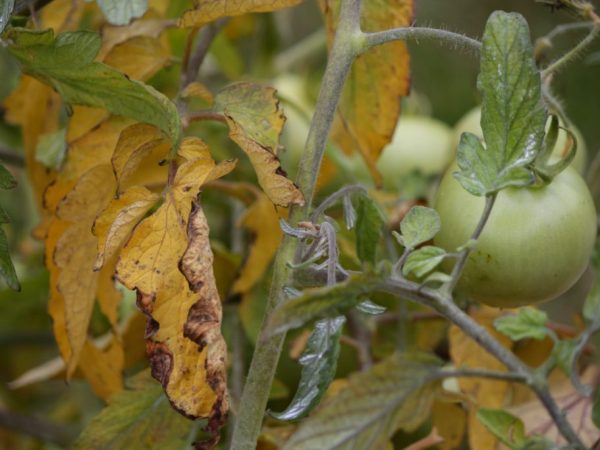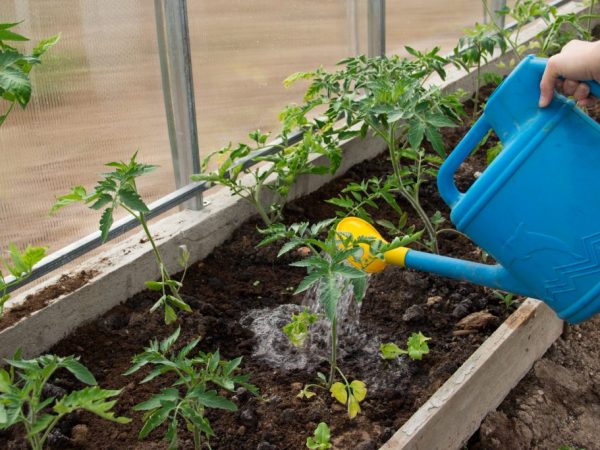Why do the leaves of tomatoes in a greenhouse get sick and turn yellow?
Tomatoes came to our beds from South America, so this culture is very fond of warmth, moisture and light. In our climatic zone, in order to provide the plant with suitable conditions, it is cultivated in greenhouses. But even in this case, gardeners encounter a lot of problems: poor germination and a small crop, pathogenic bacteria and harmful insects. More vegetable growers are concerned about why the leaves of tomatoes in a greenhouse turn yellow. There are many reasons for this phenomenon, and the consequences can be very sad.

The leaves of tomatoes in a greenhouse are sick and turn yellow
Causes of yellowing leaves
Among the many probable causes of yellowing of greenery on tomato bushes, root disturbance is in the first place, because the plant receives all the necessary substances through them. Damaged roots do not cope with their main function, and tomatoes do not receive the required amount of useful elements and water. This causes the leaves of the tomatoes in the greenhouse to turn yellow.
Root damage is of a different nature:
- mechanical intervention;
- insect damage;
- development of diseases.
Each violation of the root system of the plant must be fought.
Tomato leaves in a greenhouse can also turn yellow under the influence of climatic conditions, soil composition, due to the characteristics of the seeds and the crop variety.
Mechanical damage
The root system of young tomato sprouts is very fragile, it is very easy to break it when planting. You can harm the roots by weeding the tomato beds. By loosening the soil, driving the hoe deeply, you can easily damage the lateral processes of the roots. You should not panic at the same time: if you properly care for the culture further, the roots will grow very quickly, and there will be no trace of yellowed leaves.
Overgrowth of seedlings
Overexposure of seedlings also leads to a violation of the root system. To get an early harvest, gardeners prepare seeds for seedlings early. When the sprouted seeds are ready for planting, weather conditions or other reasons do not allow this to be done. Seedlings continue to grow in small pots, the root system of these shoots turns into a ball of tangled thin threads. Many of them will be broken during transplantation. As a result, the leaves on the tomato beds turn yellow almost immediately after transplanting.
Treatment
To help the seedlings adapt and organize proper nutrition of tomato beds, you need to spray it with a weak solution of fertilizers. These can be either phosphates, nitrates, or chlorides. The solution is rendered unsaturated. The nutrient content should not exceed 1% of the total solution volume.Foliar feeding of seedlings can be carried out daily, until the appearance of new roots and leaves, through which the plant can again receive all the necessary nutrients.
To speed up the adaptation process, the root system of the sprouts is treated with a root formation stimulator. They are used strictly in accordance with the manufacturer's instructions.
Damage by pathogenic fungi

Disease-causing fungi can harm the root system of a plant.
Pathogenic fungi can also damage the root system of tomatoes. The most common diseases that lead to yellow leaves in tomatoes in a greenhouse are fusarium and late blight.
Pathogenic fungi live in the ground, come across in tomato seeds, on garden tools that worked on infected soil.
Late blight develops on crops that are often watered on foliage in hot and sunny weather. Spots appear on the leaves, which soon begin to turn yellow.
Treatment
In the fight against fungal diseases, it is necessary to use special preparations available in large quantities in specialized stores. When using them, you must strictly adhere to the dosages recommended by the manufacturers.
To obtain the result, it is necessary to thoroughly disinfect the soil with a pink solution of manganese. It is not out of place to periodically carry out the prevention of fungal diseases. For this, vegetable crops are treated with special compounds.
Insect damage
Damage to the root system can be the intrigues of harmful insects that love to feast on the tender and juicy roots of tomatoes. The greatest harm can be caused by:
- bear;
- wireworm beetle.
Medvedka loves soils well fertilized with organic matter. She builds a nest, burrowing to a depth of no more than 15 cm, from there she gets to the roots of tomatoes and eats them. As a result, first, the leaves of tomatoes turn yellow, and then the entire vegetable crop disappears.
Fighting the bear
To combat the bear, special preparations "Medvedka" and "Thunder" have been developed. And among folk remedies, the infusion of bitter pepper has proven itself well. It is prepared at the rate of 150 g of pepper per bucket of water. The liquid is poured into the insect's burrows.
Another proven method is vinegar solution. In a bucket of water, dilute 2 cups of ordinary vinegar. This composition is poured into minks and passages laid by a bear.
Fighting the wireworm
The wireworm beetle damages tomatoes by laying its larvae near or on the roots of the plant. They eat juicy roots and make their way into plant stems. Tomatoes not only turn yellow, but soon die.
To get rid of the larvae, use a mixture of sawdust, sand and the drug "Bazudin". The resulting composition is dropped into the soil around the plants.
If in the place where the tomatoes will grow, the appearance of beetles has already been observed, it is necessary in advance, even before planting the seedlings of the culture in the greenhouse, to process the soil. To do this, a few days before transplanting, in several places throughout the garden to a depth of no more than 10 cm, small pieces of any vegetables strung on sticks 15-20 cm long are buried.The ends should look out. After 2-3 days, beetles will gather on the sticks. They need to be collected and burned.
Lack and excess of moisture

In the absence of ventilation, the plant can rot
Tomatoes turn yellow in the greenhouse not only due to root damage. Both a deficiency and an excess of moisture can lead to yellowing of the leaves. Plants evaporate a lot of moisture, and although the main root of tomatoes is very long and the plant is quite drought-resistant, the lateral roots are very close to the surface, so tomatoes require abundant watering.
If the tomatoes lack moisture, the top leaves of the plant turn yellow in the greenhouse and begin to curl.When growing tomatoes not in the open field, the opposite problem is more common: excess moisture. In this case, the leaves begin to turn yellow, the root system rots, as a result the plant will die. To prevent this from happening, it is enough to provide good ventilation of the greenhouse and adjust the irrigation regime.
Lack of nutrients
The appearance of yellow leaves on tomatoes in a greenhouse can be a signal that plant feeding is not being carried out correctly. It is possible that the wrong fertilizers are being applied or in the wrong quantities.
At all stages of the development of a garden culture, potassium, nitrogen, magnesium and other macro- and microelements are needed. Their lack, like an overabundance, negatively affects not only the greens of the tomatoes, but also the plant as a whole.
If the sprouts of the culture are weak, with thin stems, small leaves, the tomatoes receive less nitrogen. In this case, the plant is watered using nitrogen-containing fertilizers. The simplest solution is to water the tomatoes:
- urea solution;
- infusion of manure.
The lack of potassium is indicated by the appearance of small yellow dots, which subsequently merge into a single yellow spot.
To replenish potassium reserves in tomato beds, you need to water them with a potassium sulfate solution.
With a lack of manganese, young leaves first begin to turn yellow, and only then old ones. Lacking reserves of phosphorus lead not only to the appearance of yellow leaves, but also to their subsequent withering away. By twisting the yellowed leaves, the plant reacts to a lack of magnesium.
How to fix the situation
The solution to the problem is the correct feeding of the tomato beds. The best option would be to apply a complex fertilizer offered in specialized stores. They contain all the nutrients necessary for vegetable crops.
If you give preference to folk methods, it is enough to use chicken droppings. First, a mother liquor is prepared, after which every 2 liters is diluted with a bucket of clean water and the tomato beds are watered.
If healthy leaves began to turn yellow on tomatoes in a greenhouse, an urgent need to establish the cause. Yellow leaves cannot be ignored, because the consequence of this can be a lack of harvest, complete destruction of plants, contaminated soil and proliferated insects.


